Blockchain enthusiasts firmly believe in the maxim Everything is better with blockchain. Blockchain skeptics point out how quickly the mention of this technology was carried away by cunning marketers to inflate the significance of projects where the blockchain is not necessary in principle. The truth is, as usual, in the middle: a blockchain is good where its features create real, and not just advertising added value.

Conceived by the Slavic brothers from Slovenia, the project of a platform for trading electricity from renewable sources
SunContract , whose ICO is
underway now - seems to be from the first category. Experienced power engineers and IT specialists behind his idea found almost one hundred percent intersection of the market needs with the blockchain's opportunities in the field of electricity sales and distribution.
What is ICO. Mandatory Disclaimer: Initial Coin Offering is a cryptocurrency analogue of an IPO, where stocks replace tokens (smart contracts), allowing businesses to raise funds for development and simply launch without complicated and expensive procedures accompanying a public offering of stocks. In fact, this is crowdfunding for business projects, an alternative to traditional methods of financing start-ups (for example, venture capital funds).
What did they come up with?
SunContract Energy Pool is a p2p trading platform where producers of green electricity can sell it directly to consumers without intermediaries. Bidding is automated through the use of smart contracts, and the platform itself runs on the blockchain.
What is wrong with the current electricity trading system?
On average, the cost of electricity production is only one third of its retail price. 2/3 of the cost for the end user adds the cost of transporting electricity to the consumer and taxes. This is a huge administrative margin - and attempts to radically reduce or destroy it by means of modern technologies are absolutely inevitable.
At the moment, the threshold for entering the market for the production and trading of electricity is very high - to build a CHP, hydroelectric station or nuclear power plant is incredibly expensive. But the development of technologies for the production of electricity from renewable sources, primarily solar and wind energy, will radically change the situation, expanding the market for the supply of electricity at the expense of thousands and thousands of households that can afford to supply a wind turbine or at least a solar battery.
Already, in the USA alone, 15% of the electricity produced is solar and wind power. And by 2050, the sun and wind will already supply 71% of all electricity produced in the United States. In absolute volumes, growth will be even more impressive than in percentage terms, since electricity production in the United States by 2050 should grow at least twice.
The same processes, which differ only in dynamics, will go around the world: renewable energy sources will displace fossils, and almost everyone can become energy producers.
And its place under the sun in this multi trillion market and is trying to stake out the SunContract project now, launching its p2p platform for trading and distributing electricity from clean sources.
Is there really a blockchain?
Leaks and embezzlements are a congenital flaw in the energy sector in its current form: from frauds with electricity meters and the “tie-in” in the power grid at the household level to large-scale fraudulent schemes at the level of generating companies. As a result, in modern energy, huge amounts of money are spent on fraud protection and energy accounting - and still they do not provide one hundred percent protection.
As usually happens in the history of progress, where administrative measures come to a standstill, the Gordian knot of problems is cut by a new technology. In this case, the blockchain.
Transparency, immutability and traceability of transactions in the blockchain guarantee a more comfortable environment for business than any modern energy metering technology, which in one way or another is subject to corruption and human factors.
The blockchain technology, thanks to its very essence, eliminates the need for third-party services, which take over the supervisory functions of energy distribution.
It’s also eco-friendly
The ideas embodied in SunContract, contribute even to reducing carbon emissions - and the point here is not at all in the blockchain, but simply in improving the efficiency of the energy system due to greater efficiency of energy distribution from renewable sources. Because every wind turbine that runs idle because there was no buyer for its energy is some amount of carbon emissions from non-renewable energy sources that it could replace with a more efficient electricity distribution system.
ICO SunContract move
At the moment,
ICO SunContract can already be considered successful, since the first Milestone of 5000 ethers, which guarantees the development and launch of the SunContract p2p platform as such, has already been successfully passed.
Now the campaign is moving to the next level of fees - 10,000 esters, which will allow scaling the technology to the entire US renewable electricity market. A 10 percent bonus (11,000 SNC tokens per broadcast) will be reduced to 5% in just two days (10,500 SNC per broadcast).
After the launch of the platform, all SNC tokens sold on ICO will become the platform's payment tool - all calculations will be carried out at SNC, which guarantees a steadily growing demand for tokens and a corresponding increase in their prices as the electricity trading volume increases.